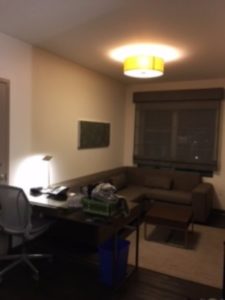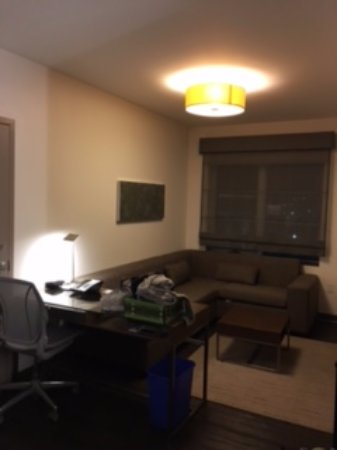Many people find that decorating their home is a tougher job than initially scoped out for. To make your life a little easier, avoid these ten mistakes that newbies to interior design often make.
1. Designing a showroom, not a home
With inspiration from the latest design magazines, we can easily find ourselves designing our homes to look uniform and showroom-esque. This can come off as a little lacklustre. To give your modern home character, think about scale and proportion when selecting your furniture. Furniture of different shapes and sizes can add dimension to a space. Lay out furniture pieces in varied scales and proportions. For example, try to have your coffee table at a different height to the couches that are around it. Using scale and proportion in a clever way can positively transform the look and feel of your home.
2. Using black in small spaces
Using black in a confined space often visually shrinks the area and makes it look even more cramped. Walls in black or dark hues as well as and bulky black furniture are the poor options when working with a home that has limited space.
Choosing lighter colours, fabrics, furniture and upholstery will improve the perceived size of smaller rooms. If you do want to add black for a touch of elegance, accent a white living room with subtle but effective accessories; a black table, a black throw on a white sofa, or a black plant pot on a window sill.
3. Getting the lighting wrong
Few things make a room feel dated like bad lighting. Good lighting can make a room more welcoming and dramatically improve its atmosphere. As well as making it easier to see, bright lighting can make a space feel livelier. Read here for some great tips on choosing the best lighting for every room of the house.
To brighten up a living room, choose and layer different lighting for each seating area, such as spotlights, reading lights and floor lamps. Ambient lighting from floor lamps and table lamps can also be a nice touch.
Another way of bringing a room to life is by replacing outdated lights with statement lighting – a standout feature that doesn’t take much work to implement.
4. Matching everything
Opting for a colour theme is a good idea, but as the famous quote goes: everything in moderation. Matching walls, furniture, curtains, accessories and carpet can be excessive and give off a bland show-room effect. A range of colours and textures can add character to a room and make a space look and feel complete.
5. Artwork overdose
Walls filled to the brim with art work make a room look crowded. Instead of many cramming frames onto your living room wall, choose a single statement piece and show off the space around it. Another tip is to hang paintings and prints at eye level. Artwork hung too high or low can throw a room off balance.
6. Bad rug positioning
When you’re working with an open floor plan, a rugs can be great features to define and separate different spaces.
It may be something that people don’t think about too much, but there is actually a science to placing rugs in an aesthetically-pleasing position. Here are a few pointers on how to position rugs:
- Evenly position a rug between the sofas it sits between
- In a large, open space, place your rug underneath the front legs of each sofa
- When placing a rug underneath a dining table, make sure that when you pull out the chairs, they stay on the rug
- In the bedroom, anchor a rug subtly at the foot of the bed
7. Clutter on show
As more new city developments pop up, multipurpose rooms are becoming more and more popular as space in these homes is often limited. To create a well-designed multipurpose room, make sure there is a designated area for each type of space, for example, study and living room area. This is key to avoiding a ‘junk room’ effect. Try to minimise clutter in these areas and use them for your set purpose solely.
Whenever using open shelving, source aesthetically pleasing or interesting objects and space them out evenly. Hidden storage on the other hand is great for unsightly belongings.
8. Getting the curtains wrong
A well-designed room with poorly hung curtains can cheapen a room and stand out in an unpleasant way.
Some of the biggest mistakes in this domain include hanging curtains at the wrong height for a set of windows and the ceiling height, as well as curtains that are too short or long. Too high and they look cheap, too low and they look careless. To achieve a finished look, drapes should barely kiss the floor or have a slight break in the fabric.
To look luxurious, curtains need body. This means they need adequate fabric meterage, which gives a fullness to the way they hang. To achieve the look:
- Use two to three times as much fabric width as the width of the curtain track or rod.
- Use a separate panel of lining attached to the back of the curtain.
This gives the curtains body and helps them to ‘float’.
9. Buying furniture you’re not mad about
You may be in a rush to furnish your new home in time for your move-in date or house-warming party. But in the long-run, it will help to be patient, do your research and find those pieces that you’ll truly enjoy – at the right price!
Haven’t found your dream furniture yet? Consider purchasing some cheaper furniture from Ikea to tie you over until you’re ready to make big purchases.
10. Test out the paint!
Testing out paint colours can save you a great deal of time and money. Paint tin colours somehow can look very different once on your living room walls. In addition, paint colours can vary in different shades of light. We recommend to buy some trial colours in similar hues – at least one shade darker and one shade lighter – and paint it on a large spot in the room of choice.
Another option is to paint directly on a large piece of the cardboard, which you can then move from room to room to decide whether the colour is suitable. This may lead you to be better informed and make better decisions: instead of a the magnolia colour you chose for the dining room, an off white would do a lot more for the space.
If you are looking into property development finance, check out more of our blog posts and guides for more useful tips and tricks.
